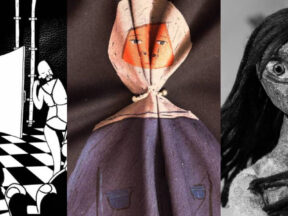

Check Out The Weird And Wonderful World Of Annecy Contrechamp Player ‘Adam Change Lentement’ (Exclusive Trailer)
A decade after his short film Le courant faible e la rivière screened in competition at Annecy, Canadian director Joël Vaudreuil is back with his debut feature Adam Change Letement, and we’ve got exclusive access to the film’s trailer.
Produced by David Pierrat and Olivier Picard at Parce Que Films, the film is a wild and weird suburban trip with a dark sense of humor and a sweetness that is easy to get behind as a viewer.
The film follows Adam, a 15-year-old teenager who has a special quirk – his body changes in reaction to mockery and negative comments he receives from those around him. The accumulation of his physical changes only adds an extra layer of complexity to those already present in his life.
We recently spoke with Vaudreuil, who told us about the film’s small-town influences and the challenges he faced in moving from short to feature filmmaking.
What were some of the visual influences that inspired you while developing the look of the film?
The little town I grew up in was the main influence for the backgrounds. With the artists who drew the backgrounds, we worked to find the right amount of detail to make it a bit minimalist. We set a limited palette of colors, so all the houses kind of look the same. It was important for me that the story takes place in a little and low-profile town. I used printed comics for references more than animation backgrounds. I wanted a dry sober look. I kept the first sketches as the main references for the characters, which they are still pretty close to. Most of the extras are drawn from pictures my friends gave me from when they were teenagers.
How did you decide what the physical manifestation of Adam’s changes would look like?
It’s a decision that naturally appeared while I was writing the script. The characters’ words kind of “decided” what would be transformed on Adam’s body. Specifically, the mean comments they say. I wanted those to be “normal,” as if the characters didn’t even notice they say mean stuff.
What required the most adaptation in making a feature film after such a long and successful career making shorts and videos?
A big challenge (but a lot of fun) in going from short to feature for me was the writing. I find it really interesting to develop characters, even if they are supporting characters. I love that. I chose to let someone else do the backgrounds too. In my short films, I did the backgrounds myself but my style is really too minimalist to keep the interest of the viewers in a feature film. I needed something more solid. I developed the style of the backgrounds with two visual artists. The main designs were made by Isabelle Guimond, then Carolyne Scenna (who also designed the accessories) completed the work in the same artistic direction, adding subtle finishing touches to the characters’ environments. But the biggest challenge still is to keep the pace for a longer film.
How did your work in shorts and videos help you when it came to making a 90-minute film?
The shorts and videos I made were kind of tests for workflows and style. With Nicolas Moussette, my chef animator, we developed a mixed technique to tune the things I didn’t like in the look of the films, using the software we had.
Directed by: Joël Vaudreuil
Production: Parce Que Films, David Pierrat, Olivier Picard
Distribution: Funfilm Distribution, Francis Ouelette
Artistic direction: Joël Vaudreuil
Script: Joël Vaudreuil
Storyboard: Joël Vaudreuil
Sets: Isabelle Guimond, Carolyne Scenna
Animation: Nicolas Moussette, Hristo Karastoyanov
Compositing: Nicolas Moussette
Music: Joël Vaudreuil
Sound: Olivier Calvert, Bernard Gariepy
Editing: Joël Vaudreuil
Voice: Simon Lacroix

.png)



